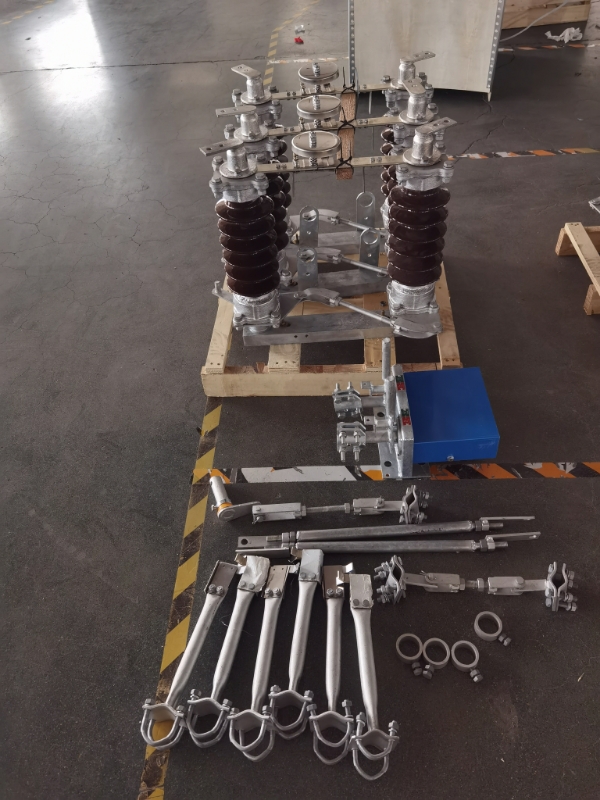
The FZN25-12RD vacuum Load switch is a critical device in 12kV distribution networks for load control and short-circuit protection. The technical performance of its core component—the vacuum interrupter chamber
Optimization Area | Specific Technical Direction | Expected Benefits |
Contact System & Magnetic Field Design | Adopt Transverse Magnetic Field (TMF) contacts; Optimize contact slot gaps (e.g., moving the starting point outward, reducing width) | Drives the arc to rotate rapidly, avoiding localized overheating; Reduces arc stagnation time, minimizing contact erosion |
Interrupter Chamber Structure & Materials | Ceramic envelope; Copper-tungsten (CuW) contact material; Solid-insulated pole process | Improves dielectric strength and mechanical strength; Enhances resistance to arc erosion; Improves insulation, adapting to harsh environments |
Operating Mechanism Coordination & Control | Direct-drive isolation gap linked with the interrupter chamber; Optimizing mechanism speed characteristics | Ensures synchronization of contact separation; Precisely controls opening/closing speeds, optimizing arc movement and extinction conditions |
Adaptation to New Power Systems | Develop high-frequency harmonic suppression algorithms; Monitor parameters like vacuum degree to assess health status | Addresses harmonic challenges from renewable energy integration; Enables predictive maintenance, enhancing power supply reliability |
Detailed Explanation of the Optimization Path for Vacuum Arc Extinction Technology
The technical directions listed in the table above form a set of interlocking systematic improvements aimed at comprehensively enhancing the switch's performance and lifespan.
- Contact System and Magnetic Field Optimization: Controlling Arc Motion
The core of the vacuum interrupter's breaking capability lies in controlling the electric arc. Optimizing the contact structure to generate a Transverse Magnetic Field (TMF) is a key technology. Through simulation-driven design, moving the starting point of the contact slots outwards or reducing the slot width can effectively help the arc bridge the slots, reducing its stagnation time on the contact surface. This avoids localized contact welding due to overheating and increases both breaking capacity and electrical lifespan.
- Interrupter Chamber Structure and Material Upgrades: Laying a Reliable Foundation
The chamber's ceramic envelope and copper-tungsten (CuW) contacts are fundamental for long-term stable operation. The ceramic envelope offers excellent insulation performance and mechanical strength, while CuW contacts are renowned for their high resistance to arc erosion. Furthermore, employing the solid-insulated pole process, where the vacuum interrupter is cast into a single unit using epoxy resin, significantly enhances the switch's overall insulation performance and environmental adaptability (e.g., moisture and pollution resistance), while also improving mechanical stability.
- Operating Mechanism Coordination and Intelligent Adaptation
The excellent performance of the interrupter chamber can only be fully realized with precise coordination from the operating mechanism. The direct-drive isolation gap linked with the vacuum interrupter design used in the FZN25-12RD ensures synchronous and reliable operation. Research indicates that optimizing the speed characteristics of the operating mechanism is also crucial. This not only increases the rotational speed of the arc on the contact surface but also influences the distribution of the inter-pole magnetic field, collectively contributing to improved breaking performance.
- Intelligent Evolution for New Power Systems
As the proportion of renewable energy increases, high-frequency harmonic issues in the grid are becoming more prominent, posing new challenges to the arc erosion resistance of Vacuum Load Switches. A patent titled "A Breaking Method for Vacuum Circuit Breakers in Renewable Energy Applications" proposes a method that involves real-time harmonic frequency extraction, dynamic adjustment of the opening strategy, and the interrupter's magnetic field. This can significantly enhance breaking stability and contact resistance to erosion under high-frequency harmonic impact.
Simultaneously, intelligence is a key development direction. By monitoring key parameters such as the vacuum degree within the interrupter chamber and analyzing operating point-on-wave errors, the health status of the switch can be accurately assessed and predicted. This facilitates a shift from "time-based maintenance" to predictive maintenance, greatly improving power supply reliability.

Summary
Through continuous optimization across these four levels—contact magnetic field, structural materials, coordinated control of the operating mechanism, and intelligent adaptation to new technologies—the vacuum arc extinction technology represented by the FZN25-12RD vacuum load switch is evolving towards being more secure, more durable, and more intelligent. This is of paramount importance for meeting the operational demands of increasingly complex distribution networks, particularly in adapting to new scenarios involving high penetration of renewable energy.
Oil&Gas exploited
Automotive Manufacturing
Transportation & Dlistrlbutlon
Manufacture
Industrial Construction
Green Energy
Copyright ? 2024 All Rights Reserved
Back to top 
Comment
(0)